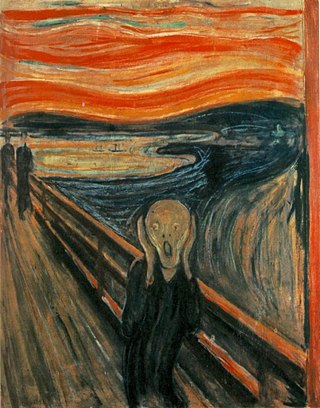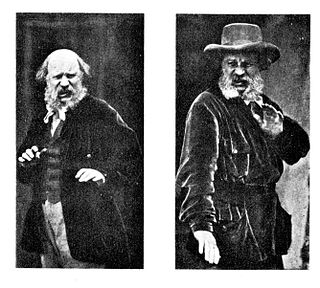
Arachnophobia is a specific phobia brought about by the irrational fear of spiders and other arachnids such as scorpions and ticks. The word Arachnophobia comes from the Greek words arachne and phobia.

A phobia is an anxiety disorder, defined by a persistent and excessive fear of an object or situation. Phobias typically result in a rapid onset of fear and are usually present for more than six months. Those affected go to great lengths to avoid the situation or object, to a degree greater than the actual danger posed. If the object or situation cannot be avoided, they experience significant distress. Other symptoms can include fainting, which may occur in blood or injury phobia, and panic attacks, often found in agoraphobia and emetophobia. Around 75% of those with phobias have multiple phobias.

Anxiety disorders are a cluster of mental disorders characterized by significant and uncontrollable feelings of anxiety and fear such that a person's social, occupational, and personal functions are significantly impaired. Anxiety may cause physical and cognitive symptoms, such as restlessness, irritability, easy fatigue, difficulty concentrating, increased heart rate, chest pain, abdominal pain, and a variety of other symptoms that may vary based on the individual.
Specific phobia is an anxiety disorder, characterized by an extreme, unreasonable, and irrational fear associated with a specific object, situation, or concept which poses little or no actual danger. Specific phobia can lead to avoidance of the object or situation, persistence of the fear, and significant distress or problems functioning associated with the fear. A phobia can be the fear of anything.

Claustrophobia is a fear of confined spaces. It is triggered by many situations or stimuli, including elevators, especially when crowded to capacity, windowless rooms, and hotel rooms with closed doors and sealed windows. Even bedrooms with a lock on the outside, small cars, and tight-necked clothing can induce a response in those with claustrophobia. It is typically classified as an anxiety disorder, which often results in panic attacks. The onset of claustrophobia has been attributed to many factors, including a reduction in the size of the amygdala, classical conditioning, or a genetic predisposition to fear small spaces.
Erotophobia is a term coined by a number of researchers in the late 1970s and early 1980s to describe one pole on a continuum of attitudes and beliefs about sexuality. The model of the continuum is a basic polarized line, with erotophobia at one end and erotophilia at the other end.
Phobophobia is a phobia defined as the fear of phobias, or the fear of fear, including intense anxiety and unrealistic and persistent fear of the somatic sensations and the feared phobia ensuing. Phobophobia can also be defined as the fear of phobias or fear of developing a phobia. Phobophobia is related to anxiety disorders and panic attacks directly linked to other types of phobias, such as agoraphobia. When a patient has developed phobophobia, their condition must be diagnosed and treated as part of anxiety disorders.
In psychology, Desensitization is a treatment or process that diminishes emotional responsiveness to a negative, aversive, or positive stimulus after repeated exposure. Desensitization can also occur when an emotional response is repeatedly evoked when the action tendency associated with the emotion proves irrelevant or unnecessary. The process of desensitization was developed by psychologist Mary Cover Jones and is primarily used to assist individuals in unlearning phobias and anxieties. Desensitization is a psychological process where a response is repeatedly elicited in circumstances where the emotion's propensity for action is irrelevant. Joseph Wolpe (1958) developed a method of a hierarchal list of anxiety-evoking stimuli in order of intensity, which allows individuals to undergo adaptation. Although medication is available for individuals with anxiety, fear, or phobias, empirical evidence supports desensitization with high rates of cure, particularly in clients with depression or schizophrenia. Wolpe's "reciprocal inhibition" desensitization process is based on well-known psychology theories such as Hull's "drive-reduction" theory and Sherrington's concept of "reciprocal inhibition." Individuals are gradually exposed to anxiety triggers while using relaxation techniques to reduce anxiety. It is an effective treatment for anxiety disorders.
Blood phobia is an extreme irrational fear of blood, a type of specific phobia. Severe cases of this fear can cause physical reactions that are uncommon in most other fears, specifically vasovagal syncope (fainting). Similar reactions can also occur with trypanophobia and traumatophobia. For this reason, these phobias are categorized as blood-injection-injury phobia by the DSM-IV. Some early texts refer to this category as "blood-injury-illness phobia."
Social anxiety is the anxiety and fear specifically linked to being in social settings. Some categories of disorders associated with social anxiety include anxiety disorders, mood disorders, autism spectrum disorders, eating disorders, and substance use disorders. Individuals with higher levels of social anxiety often avert their gazes, show fewer facial expressions, and show difficulty with initiating and maintaining a conversation. Social anxiety commonly manifests itself in the teenage years and can be persistent throughout life; however, people who experience problems in their daily functioning for an extended period of time can develop social anxiety disorder. Trait social anxiety, the stable tendency to experience this anxiety, can be distinguished from state anxiety, the momentary response to a particular social stimulus. Half of the individuals with any social fears meet the criteria for social anxiety disorder. Age, culture, and gender impact the severity of this disorder. The function of social anxiety is to increase arousal and attention to social interactions, inhibit unwanted social behavior, and motivate preparation for future social situations.

Thalassophobia is the persistent and intense fear of deep bodies of water such as the sea, oceans, or lakes. Though very closely related, thalassophobia should not be confused with aquaphobia which is classified as the fear of water itself. Thalassophobia can include fear of being in deep bodies of water, fear of the vast emptiness of the sea, of sea waves, aquatic creatures, and fear of distance from land.
Misophonia is a disorder of decreased tolerance to specific sounds or their associated stimuli, or cues. These cues, known as "triggers", are experienced as unpleasant or distressing and tend to evoke strong negative emotional, physiological, and behavioral responses that are not seen in most other people. Misophonia and misophonic symptoms can adversely affect the ability to achieve life goals and enjoy social situations. It was first recognized in 2001, though it is still not in the DSM-5 or any similar manual. For this reason it has been called a "neglected disorder".
Blood-injection-injury (BII) type phobia is a type of specific phobia characterized by the display of excessive, irrational fear in response to the sight of blood, injury, or injection, or in anticipation of an injection, injury, or exposure to blood. Blood-like stimuli may also cause a reaction. This is a common phobia with an estimated 3-4% prevalence in the general population, though it has been found to occur more often in younger and less educated groups. Prevalence of fear of needles which does not meet the BII phobia criteria is higher. A proper name for BII has yet to be created.
Most people have a fear of medical procedures at some point in their lifetime, which can include the fear of surgery, dental work, doctors, or needles. These fears are seldom diagnosed or treated, as they are often extinguished into adulthood and do not often develop into phobias preventing individuals from seeking medical attention. Formally, medical fear is defined as "any experience that involves medical personnel or procedures involved in the process of evaluating or modifying health status in traditional health care settings."

Disgust is an emotional response of rejection or revulsion to something potentially contagious or something considered offensive, distasteful or unpleasant. In The Expression of the Emotions in Man and Animals, Charles Darwin wrote that disgust is a sensation that refers to something revolting. Disgust is experienced primarily in relation to the sense of taste, and secondarily to anything which causes a similar feeling by sense of smell, touch, or vision. Musically sensitive people may even be disgusted by the cacophony of inharmonious sounds. Research has continually proven a relationship between disgust and anxiety disorders such as arachnophobia, blood-injection-injury type phobias, and contamination fear related obsessive–compulsive disorder.
Guided imagery is a mind-body intervention by which a trained practitioner or teacher helps a participant or patient to evoke and generate mental images that simulate or recreate the sensory perception of sights, sounds, tastes, smells, movements, and images associated with touch, such as texture, temperature, and pressure, as well as imaginative or mental content that the participant or patient experiences as defying conventional sensory categories, and that may precipitate strong emotions or feelings in the absence of the stimuli to which correlating sensory receptors are receptive.
Autophobia, also called monophobia, isolophobia, or eremophobia, is the specific phobia or a morbid fear or dread of oneself or of being alone, isolated, abandoned, and ignored. This specific phobia is associated with the idea of being alone, often causing severe anxiety.
Fear-potentiated startle (FPS) is a reflexive physiological reaction to a presented stimulus, and is an indicator of the fear reaction in an organism. The FPS response can be elicited in the face of any threatening stimulus, but it can also be elicited by a neutral stimulus as a result of fear conditioning, a process that occurs when a benign stimulus comes to evoke fear and anxiety upon being paired with a traumatic or fear-provoking event. The stimulus in question is usually of auditory or visual nature, and startle response measures include eyeblink rates and pulse/heart rate. The negative impact of heightened FPS in the face of neutral stimuli can be treated pharmacologically, using psychotropic medications that are typically used to reduce anxiety in humans. Recent literature, moreover, has implicated increased FPS responses as a correlate in posttraumatic stress disorder (PTSD) and other anxiety disorders.

A hole is an opening in or through a particular medium, usually a solid body. Holes occur through natural and artificial processes, and may be useful for various purposes, or may represent a problem needing to be addressed in many fields of engineering. Depending on the material and the placement, a hole may be an indentation in a surface, or may pass completely through that surface.
Ommetaphobia is an irrational fear of eyes.






